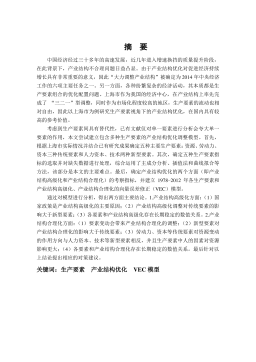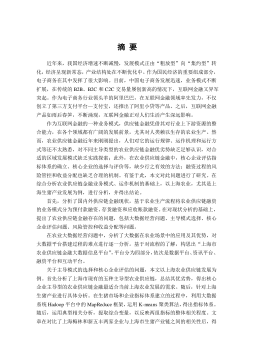中小企业营销差异化战略与出口绩效
摘要随着经济全球化进程的加快,越来越多的中小企业通过互联网平台参与到国际市场竞争中,这些企业不可避免地要受到国际市场竞争环境的影响。面对复杂多变的国际市场环境,我国中小企业是否应该利用差异化营销战略来提高自身的出口绩效以及采用什么样的差异化战略来提高出口绩效,就成为我们关注的问题。本研究的主要目的在于探讨中小企业差异化战略和出口绩效之间的关系,并在此基础上探讨互联网的应用对差异化战略和出口绩效的影响。论文借鉴以往的研究经验,并在此基础上提出差异化战略与出口绩效之间关系的研究假设。在研究过程中,论文采用问卷调研的方法,主要选取我国长三角地区的中小出口企业为调查对象(样本共计140家),并在此基础...
相关推荐
-
我国基层财政困难的制度成因分析与对策研究VIP免费

 2024-09-20 46
2024-09-20 46 -
我国煤电产业链纵向交易合约机制研究VIP免费

 2024-09-20 44
2024-09-20 44 -
生产要素视角下的上海市产业结构优化研究VIP免费

 2025-01-09 8
2025-01-09 8 -
我国银行业结构与经济结构关系研究VIP免费

 2025-01-09 18
2025-01-09 18 -
大数据视角下农业供应链金融研究VIP免费

 2025-01-09 14
2025-01-09 14 -
跨国大型综合超市的规划研究VIP免费

 2025-01-09 9
2025-01-09 9 -
跨境电商农产品质量安全问题研究VIP免费

 2025-01-09 9
2025-01-09 9 -
世界市场的虚拟化与我国国际电子商务发展方向研究VIP免费

 2025-01-09 46
2025-01-09 46 -
中国政府对电力行业的价格规制问题研究VIP免费

 2025-01-09 20
2025-01-09 20 -
中小企业信息化系统集成技术研究VIP免费

 2025-01-09 30
2025-01-09 30
相关内容
-

跨国大型综合超市的规划研究
分类:高等教育资料
时间:2025-01-09
标签:无
格式:PDF
价格:15 积分
-

跨境电商农产品质量安全问题研究
分类:高等教育资料
时间:2025-01-09
标签:无
格式:PDF
价格:15 积分
-

世界市场的虚拟化与我国国际电子商务发展方向研究
分类:高等教育资料
时间:2025-01-09
标签:无
格式:PDF
价格:15 积分
-

中国政府对电力行业的价格规制问题研究
分类:高等教育资料
时间:2025-01-09
标签:无
格式:PDF
价格:15 积分
-

中小企业信息化系统集成技术研究
分类:高等教育资料
时间:2025-01-09
标签:无
格式:PDF
价格:15 积分





